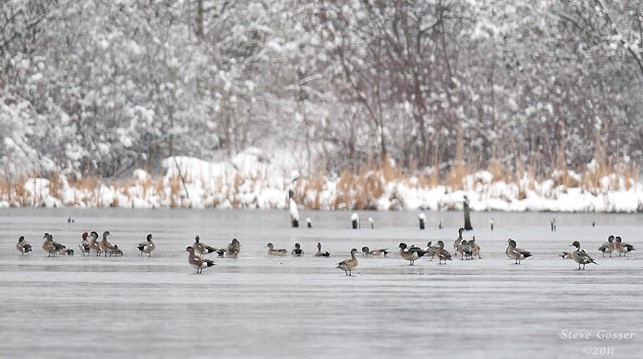
Ducks are migrating through Pennsylvania right now so I’ve been brushing up on my identification skills.
Because I don’t own a scope, I have to identify ducks from a distance using 8- or 10-power binoculars. They always look small and their colors are muted but I’m able to do it by looking at their behavior, relative size, body shapes and color patterns.
Here are quick some tips I use to identify distant ducks. Perhaps they’ll work for you. (Some of you are already experts at this. Let us know your tips by leaving a comment.)
First, get to know a common duck really well. I suggest studying mallards because they’re everywhere and easy to watch. What do they look like? Study males and females near, far and very far away. Use them as your point of reference.
Second, watch duck behavior. How do they feed? Do they dabble or dive?
Dabblers eat shallow food they pick from the water’s surface or pull from the bottom by tipping their butts in the air and reaching underwater with their heads and necks. They don’t submerge. Dabblers leap into flight directly from the water.
Divers completely submerge and swim underwater to get their food.
Below I’ve listed only dabblers (there are too many ducks for one blog!) and to save space I’ve abbreviated: “=M” is same size as mallard, “<M” smaller than mallard, “HFAM” means “Hope For A Male” because the females are hard to identify. (Yes, I’ll admit I sometimes ignore the females too hard to identify from afar.)
- Mallard: This is your reference duck. 23″ long. Male has green head, brown chest, whitish belly & back. Female is speckled brown and boring. Females of some other species resemble her.
- Wood duck: <M. Short neck. Distinctive head feathers drape over back of neck like long hair. Males colorful but if too distant to see color, look at the “hair.” Females gray, have shorter “hair,” and big white area around their eyes.
- American Black Duck: =M. Like a dark female mallard. Hope it flies & shows its white underwings.
- Gadwall: =M. Shape is ‘mallard’ with rounder head. Male is bland, brownish-gray with a black butt. HFAM.
- American wigeon: slightly <M. Males have white forehead on gray head with green accent. Sides are rusty. Butt is white-that-ends-in-black. Female’s rusty sides, white belly make her more colorful than female mallard.
- Northern pintail: =M. Long thin neck. Elegant in every way. Males have chocolate brown head, white neck stripe, gray body, long tail — and they happen to have a white-then-black butt but the “pintail” is the big clue. Female is elegant mallard.
- Northern shoveler: =M. Very long wide bill is the “shovel.” Nearly neckless, sits low in the water. Males have dark green head, rust on sides, white chest. Females are boring brown but the bill is the big clue.
- Green-winged teal: Small duck, noticeably <M. Nicknamed “butter butt” because it has a creamy yellow butt. Male has dark head with teal-green accent. HFAM if there are blue-winged teal in the flock.
- Blue-winged teal: Small duck, noticeably <M. Male has white crescent moon on his face. HFAM if there are green-winged teal present.
- NOT A DUCK but is a dabbler –> American coot: all black with small head, white bill and forehead shield. Hangs out in big flocks, clucking, whining, chattering. Runs on the water to take off.
Do you think you can identify the ducks in the photo now?
(photo by Steve Gosser, March 2011)
I see Pintail, wigeon, GWT, Mallard, and a redhead. . . I think
Great info and post on the ducks. I will be nice to start seeing some of our winter ducks back in town. have a great weekend!
I always look forward to the arrival of ducks and other waterfowl to our area. This is a great post, btw.